by Walt Anderson
Tuesday, July 13, 2021. Remember the date. Prescott, Arizona City Council voted 7-0 to approve the annexation of thousands of acres of land owned by Arizona Eco Development into the city, with the prize being 474 acres of natural open space now under city protection. This culminates a five-year process in which a few caring citizens formed a political action committee, Save the Dells, to achieve this very goal. Save the Dells garnered enormous public support, and through long, sometimes very difficult, negotiations, this date turns out to be the win-win-win successful compromise for Prescott, the people, and the developer. And let’s not forget the thousands of animals that depend on that ecosystem!
Most developments in the county in the past have faced very little resistance, and councils have routinely approved them with little organized public input or resistance. This was different. The extremely popular Peavine National Recreation Trail and its Prescott Valley partner, the Iron King Trail, wind through the spectacular valleys and peaks of the Granite Dells, a world-class landscape that most people took for granted. However, one historic ranch encompassing miles of those trails ended up slated for development. At a time when the city had already acquired some land in the Dells, proving the landscape’s enormous popularity, it suddenly seemed that this incomparable gemstone would be fragmented into bits of costume jewelry.
I originally planned this Wild Wednesday as a celebration of this gorgeous place. In some ways it still is, but it also must call attention to an unprecedented weather phenomenon that struck this paradise two days before on July 11. Perhaps that date should stay in our memories too, for its impacts will also have far-reaching effects.
Please follow the narrative accompany these photos, as you will discover the incredible power of Mother Nature and also see some of the wonderful wild survivors of this apocalyptic event. In the end, please rejoice with all of us who fought to save a vital part of the Dells. It took vision, intelligence, persistence, and good will to achieve this. It is an important step toward a greater Granite Dells Regional Park and Preserve, and it is a model for effective citizen engagement that we hope many others will follow.
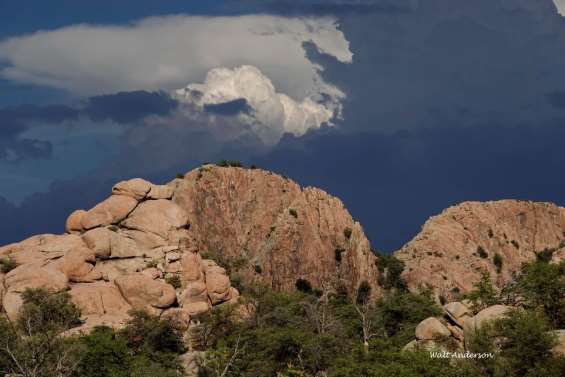
Easter Peak in the heart of Granite Dells as a storm brews in the background on 7/9/21. The foreground rocks and trees are part of the natural open space protected in this annexation.

The same scene after the city council vote on the afternoon of 7/13/21. Note the defoliation of all the foreground trees. It’s summer, so how is this possible?
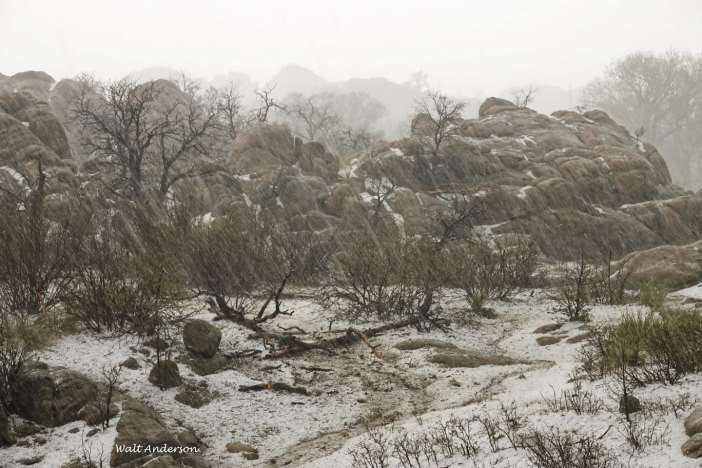
Around 3:30 p.m. on 7/11/21, an enormous, ominous gray wall descended from Glassford Hill to the east accompanied by a terrifying roar like being sucked into a jet engine. In seconds, hail began pelting our house, a barrage of frozen rocks driven by winds of Category 1 hurricane force. We feared that every window would break under the impact of these missiles, and we discovered later that exactly that had happened for some neighbors. Hailstones the size of gumballs up to golf balls pelted and almost instantly pulverized the plants in pots on our deck.
In this scene, all the trees and shrubs were already pounded leafless. The temperature had dropped almost instantly from over 100 F to 50! We feared for the many quail families that had been visiting our place, the rabbits, the nesting birds. The storm went on and on, relentless, devastating.

Just before Point of Rocks as you come from the south is a fine stand of tall Ponderosa Pines in front of some of the highest peaks in the Dells, a classic scene that I have photographed many times. After the hailaceous storm, this looked like a war zone. It will be fascinating to watch what recovers and what doesn’t. This is a test of the ecosystem’s resilience.
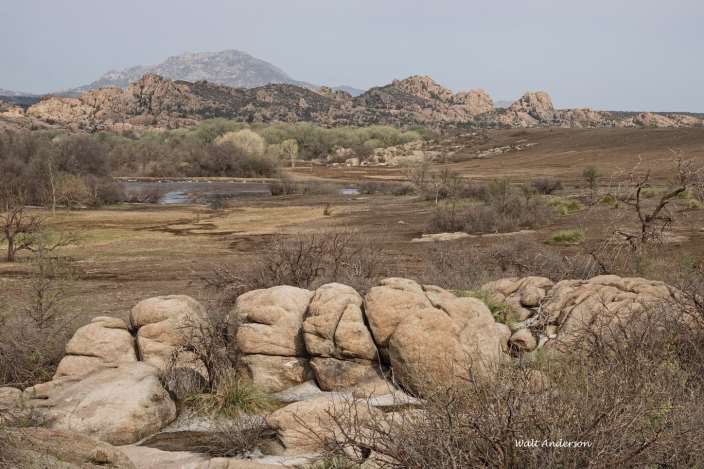
The beautiful valley where No-name Creek intersects with Granite Creek was hammered hard. A week ago, it was all green. The denuded ridge on the right is where the Native American ruins are. This valley was slated to have roads and many houses in the original proposal, even though this is a floodplain. We are thrilled that this valley with its important wildlife and recreation values will be saved, as will an important stretch of riparian gallery forest along Granite Creek.

Just outside of the protected Dells land is a once-grassy ridge that is destined to be a resort. The hail scalped the slopes. The annexation compromise assures that only a resort—no mass housing—can be constructed here, and it is to be done with sensitivity to the viewscape. The city must approve a master development plan for the site, and that process will also involve public input. There is much more for the citizens of Prescott to be aware of and to let their voices be heard.
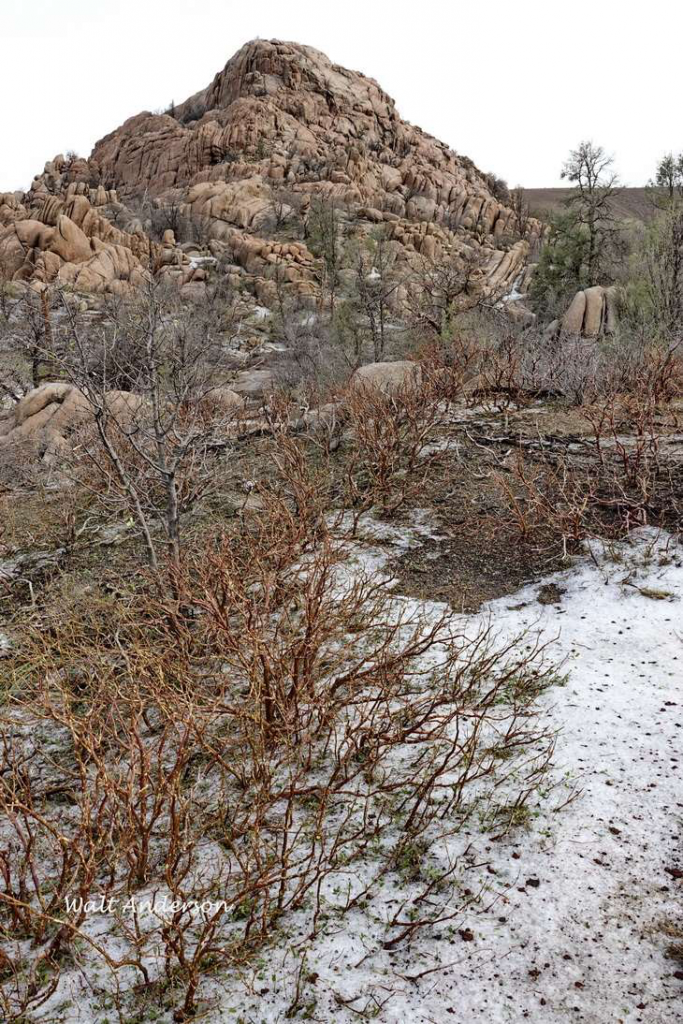
Most Dells vegetation is evergreen because of the arid environment. Manzanitas and oaks hold their leaves through the winter. This post-hailstorm scene does not resemble winter at all; it looks more like a devastating fire has blasted through.

Manzanita blasted by the storm. Most plants after such a loss of leaf would be photosynthetically challenged, but manzanita has some tricks up its twigs. Scratch the smooth red bark, and you’ll get a strip of green, for chlorophyll lies right beneath the surface of what functions like sunscreen. These stem cells power up their little solar collectors and take over when the leaves are gone. That’s an option that the oaks simply do not have. However, the manzanita shrubs were already quite stressed from the ongoing drought, so it remains to be seen how well they may actually recover.
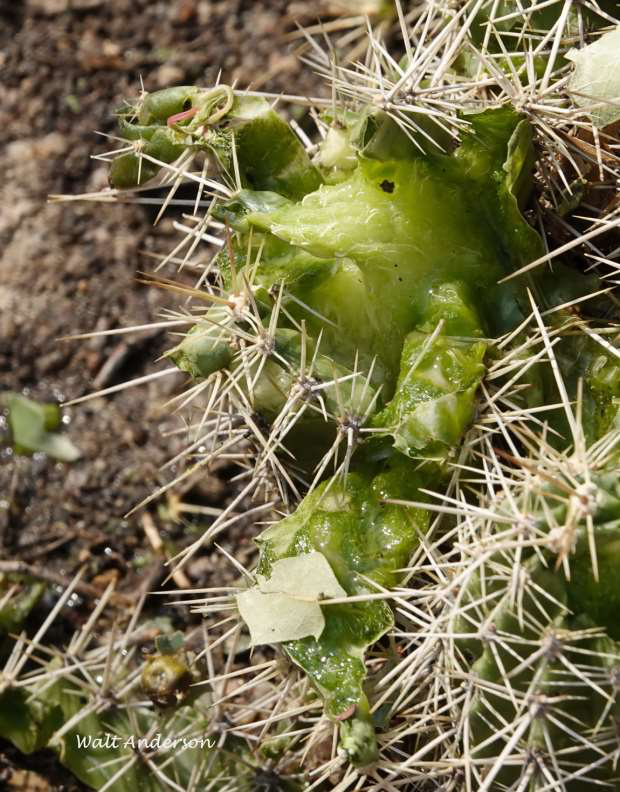
Claretcup cacti are well-armed against most threats, but a stoning on this scale overcame some of those defenses. The physical damage is obvious, but secondary infections by microbes might be even worse.
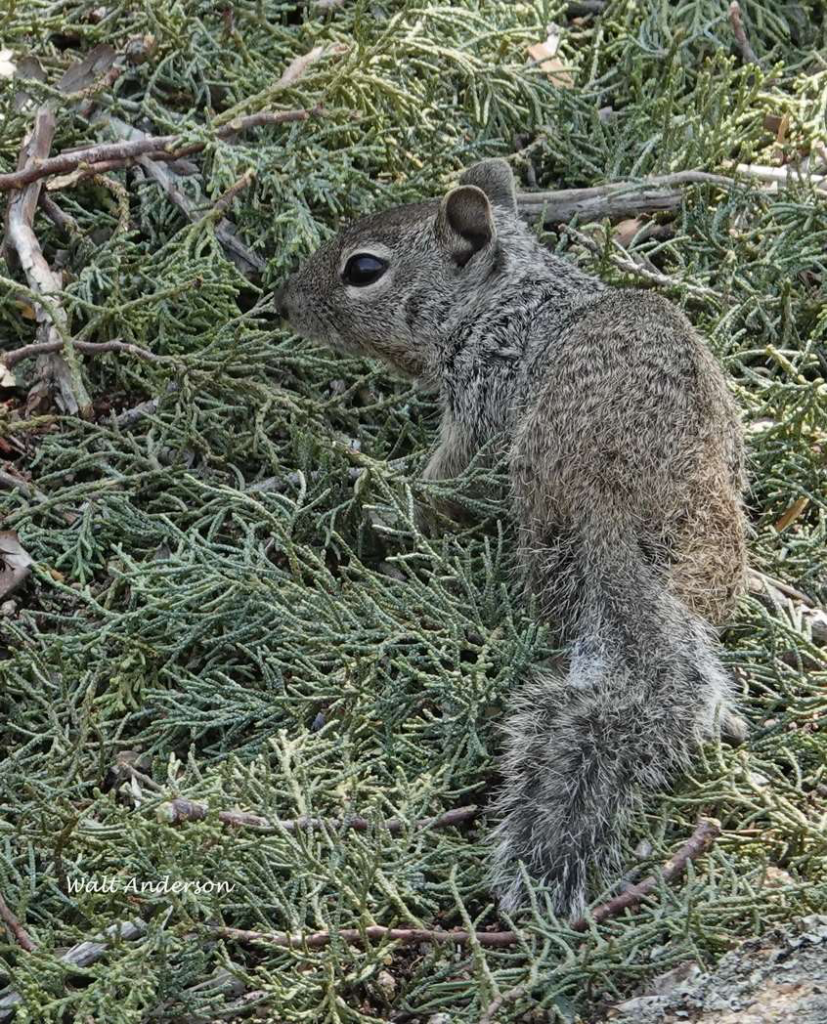
Alligator Junipers and Pinyons were not spared the defoliating barrage either. I was delighted to find this Rock Squirrel checking out the bed of juniper foliage below a skeletonized tree. Even in the midst of devastation, life goes on.
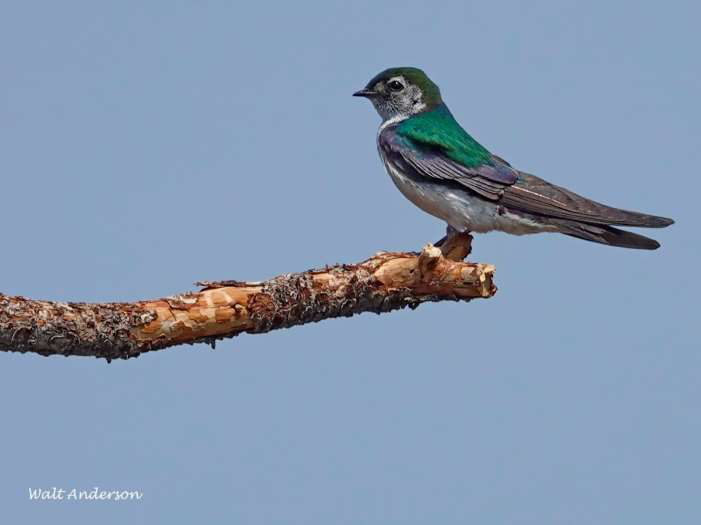
Violet-green Swallows, cliff nesters, had their nests protected from the icy bombs, but cup-nesting birds were undoubtedly hit hard. The swallows, however, may find reduced aerial insect prey, since there is no foliage for bugs to feed upon. On the other hand, mosquitoes may breed in the temporary tinajas, and swallows may find a banquet as the insects hatch and take to the air. Just as in annexation negotiations, compromises are inevitable.

Even as I was surveying the physical damage from the storm, I was rewarded by the life that I found, everything making the most of the hands they were dealt. When things don’t go as planned, then you’d better wing it.
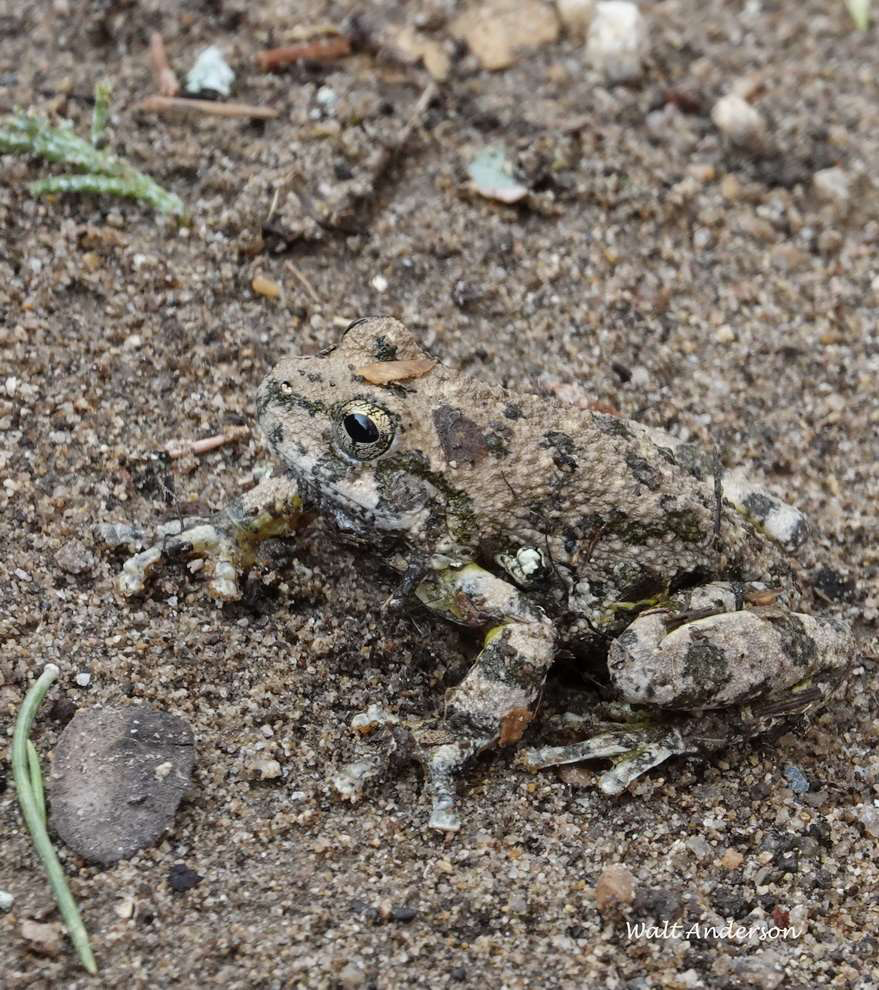
I explored up Boulder Creek on one of Prescott’s great trails, but at times, evidence of the trail had been washed away, buried in tattered leaves, or blocked by big drifts of hail, sticky marbles melting together in piles that would last for days, even in the summer heat. The creek, dry until now, was flowing vigorously, foaming with bubbles in brand-new pools. Suddenly a piece of decomposed granite moved slightly, and I realized it was a Canyon Treefrog, so perfectly camouflaged that only movement would give it away. Wow!

This piece of animated granite then moved up onto a cliff face. If I looked away for a second, I struggled to find the amazing creature again. This is the epitome of crypticity. Now that the creek is running, tree frogs can go about their courtship and egg-laying. I marvel at the patience they have, sitting nearly motionless for ridiculous periods of time, more rock than frog, but being ready to make hay when the creek flows.

The Plateau Striped Whiptail spends the cold months below ground, but in the summer heat, it is a hyper critter, twitching and jerking along in search of insect prey. What an amazing contrast of lifestyles compared to that of the sedentary tree frog! The diversity of life history strategies is what keeps us naturalists ever curious and inspired.

A young Red-tailed Hawk, not long out of the nest, screamed in apparent displeasure as I passed the sculpted crag upon which it sat. I was intrigued by the patterns here.
The natural world is endlessly fascinating, and we need large patches of functional open space so that even when a local disaster strikes, there are refugia for survivors that can breed and move back into the damaged site. This is part of the rationale for a large, interconnected series of habitats that together create a viable regional park and preserve. The open space saved in the AED annexation will be a lasting legacy for the community of humans and wildlife that will continue to live here. But we can’t take anything for granted. Resisting encroachment and managing the land wisely are our lasting obligation and reward.
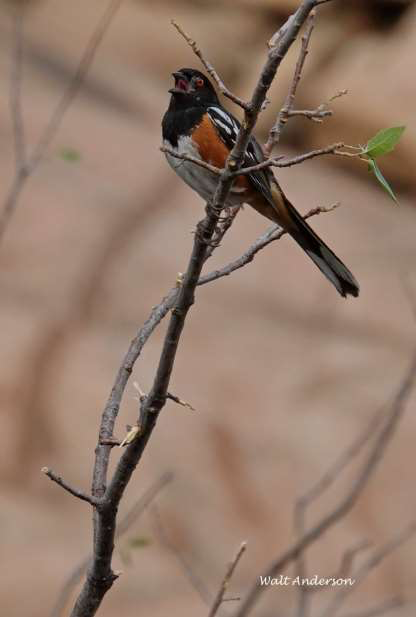
So I want to sing the praises of all parties who worked in good faith and contributed to success in this long annexation process. What could have been a disaster has become a victory that should stand as a model for other communities that face rapid growth and development.
The drive to save more of the Granite Dells to create a world-class regional park and preserve goes on. It’s an exciting challenge that we invite all caring people in this community to join. Please support the politically active Save the Dells group and also help out the non-profit Granite Dells Preservation Foundation, which is dedicated to protecting and interpreting this magnificent treasure. Your support, large or small, will make a difference. There is currently an online auction devoted to raising funds for the Dells: https://www.32auctions.com/GDPF21.
Let’s keep Spotted Towhees and all wildlife thriving through our own generous efforts!
